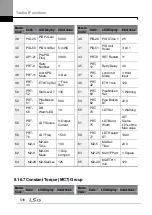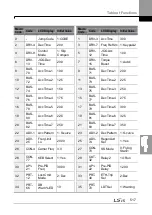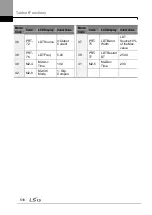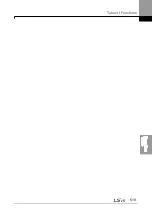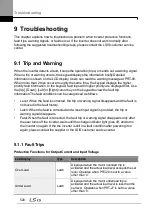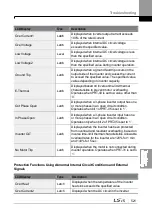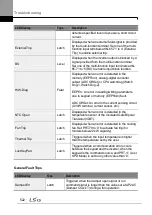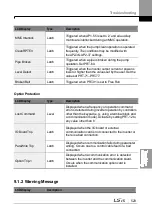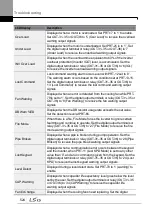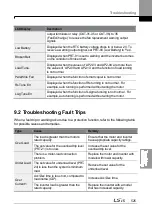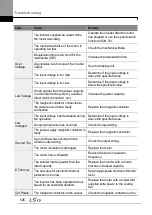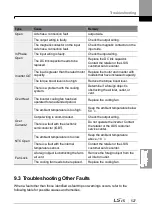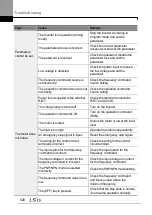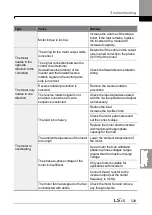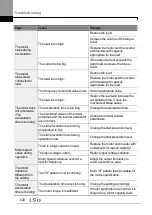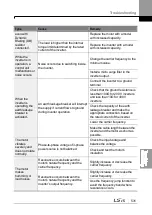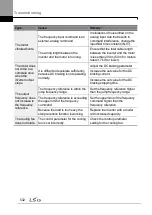
Troubleshooting
530
Type
Cause
Remedy
The motor
stops during
acceleration.
The load is too high.
Reduce the load.
Increase the volume of the torque
boost.
Replace the motor and the inverter
with models with capacity
appropriate for the load.
The current is too big.
If the output current exceeds the
rated load, decrease the torque
boost.
The motor
stops when
connected to
load.
The load is too high.
Reduce the load.
Replace the motor and the inverter
with models with capacity
appropriate for the load.
The motor does
not accelerate.
/The
acceleration
time is too long.
The frequency command value is low. Set an appropriate value.
The load is too high.
Reduce the load and increase the
acceleration time. Check the
mechanical brake status.
The acceleration time is too long.
Change the acceleration time.
The combined values of the motor
properties and the inverter parameter
are incorrect.
Change the motor related
parameters.
The stall prevention level during
acceleration is low.
Change the stall prevention level.
The stall prevention level during
operation is low.
Change the stall prevention level.
Motor speed
varies during
operation.
There is a high variance in load.
Replace the motor and inverter with
models with increased capacity.
The input voltage varies.
Reduce input voltage variation.
Motor speed variations occur at a
specific frequency.
Adjust the output frequency to
avoid a resonance area.
The motor
rotation is
different from
the setting.
The V/F pattern is set incorrectly.
Set a V/F pattern that is suitable for
the motor specification.
The motor
deceleration
time is too long
The deceleration time is set too long.
Change the setting accordingly.
The motor torque is insufficient.
If motor parameters are normal, it is
likely to be a motor capacity fault.
Summary of Contents for H100
Page 14: ......
Page 18: ...Preparing the Installation 4 37 90 kW 3 Phase ...
Page 27: ...Preparing the Installation 13 ...
Page 47: ...33 Installing the Inverter ...
Page 48: ...Installing the Inverter 34 Input and Output Control Terminal Block Wiring Diagram ...
Page 61: ...47 Installing the Inverter ...
Page 71: ...Learning to Perform Basic Operations 57 ...
Page 88: ...Learning to Perform Basic Operations 74 ...
Page 103: ...89 Learning Basic Features Code Description V1 Quantizing ...
Page 129: ...115 Learning Basic Features ...
Page 140: ...Learning Basic Features 126 ...
Page 148: ...Learning Basic Features 134 ...
Page 171: ...157 Learning Advanced Features Deceleration dwell operation ...
Page 183: ...169 Learning Advanced Features ...
Page 184: ...Learning Advanced Features 170 PID Command Block ...
Page 185: ...171 Learning Advanced Features PID Feedback Block ...
Page 186: ...Learning Advanced Features 172 PID Output Block ...
Page 187: ...173 Learning Advanced Features PID Output Mode Block ...
Page 197: ...183 Learning Advanced Features ...
Page 201: ...187 Learning Advanced Features Code Description 100 EPID1 Control block ...
Page 202: ...Learning Advanced Features 188 EPID2 Control block ...
Page 237: ...223 Learning Advanced Features Time Period Schedule AP3 38 Except3 Day 01 01 ...
Page 244: ...Learning Advanced Features 230 ...
Page 259: ...245 Learning Advanced Features Code Description Code Description Volt ...
Page 362: ...Learning Protection Features 348 ...
Page 415: ...401 RS 485 Communication Features Item Standards Parity check None ...
Page 524: ...Table of Functions 510 ...
Page 533: ...Table of Functions 519 ...
Page 547: ...533 Troubleshooting ...
Page 585: ...Technical Specification 571 ...
Page 594: ...580 ...
Page 595: ...581 ...
Page 596: ...582 ...

